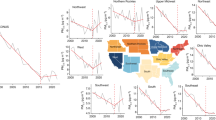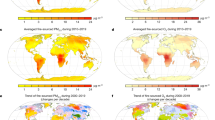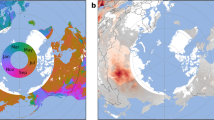Abstract
Increases in the severity and frequency of large fires necessitate improved understanding of the influence of smoke on air quality and public health. The objective of this study is to estimate the effect of smoke from fires across the continental U.S. on regional air quality over an extended period of time. We use 2006–2013 data on ozone (O3), fine particulate matter (PM2.5), and PM2.5 constituents from environmental monitoring sites to characterize regional air quality and satellite imagery data to identify plumes. Unhealthy levels of O3 and PM2.5 were, respectively, 3.3 and 2.5 times more likely to occur on plume days than on clear days. With a two-stage approach, we estimated the effect of plumes on pollutants, controlling for season, temperature, and within-site and between-site variability. Plumes were associated with an average increase of 2.6 p.p.b. (2.5, 2.7) in O3 and 2.9 µg/m3 (2.8, 3.0) in PM2.5 nationwide, but the magnitude of effects varied by location. The largest impacts were observed across the southeast. High impacts on O3 were also observed in densely populated urban areas at large distance from the fires throughout the southeast. Fire smoke substantially affects regional air quality and accounts for a disproportionate number of unhealthy days.
This is a preview of subscription content, access via your institution
Access options
Subscribe to this journal
Receive 6 print issues and online access
$259.00 per year
only $43.17 per issue
Buy this article
- Purchase on Springer Link
- Instant access to full article PDF
Prices may be subject to local taxes which are calculated during checkout



Similar content being viewed by others
References
Dennekamp M, Abramson MJ. The effects of bushfire smoke on respiratory health. Respirology. 2011;16:198–209.
Dennekamp M, Straney LD, Erbas B, Abramson MJ, Keywood M, Smith K, et al. Forest fire smoke exposures and out-of-hospital cardiac arrests in Melbourne, Australia: a case-crossover study. Environ Health Perspect. 2015;123:959–64.
Haikerwal A, Akram M, Del Monaco A, Smith K, Sim MR, Meyer M, et al. Impact of fine particulate matter (PM2.5) exposure during wildfires on cardiovascular health outcomes. J Am Heart Assoc. 2015;4:e001653
Haikerwal A, Akram M, Sim MR, Meyer M, Abramson MJ, Dennekamp M. Fine particulate matter (PM2.5) exposure during a prolonged wildfire period and emergency department visits for asthma. Respirology. 2016;21:88–94.
Johnston FH, Henderson SB, Chen Y, Randerson JT, Marlier M, DeFries RS, et al. Estimated global mortality attributable to smoke from landscape fires. Environ Health Perspect. 2012;120:695–701.
Rappold AG, Stone SL, Cascio WE, Neas LM, Kilaru VJ, Carraway MS, et al. Peat bog wildfire smoke exposure in rural North Carolina is associated with cardiopulmonary emergency department visits assessed through syndromic surveillance. Environ Health Perspect. 2011;119:1415–20.
Climate Central. The Age of Western Wildfires [Internet]. www.climatecentral.org. 2012 [cited 7 May 2017]. Available at: http://www.climatecentral.org/news/report-the-age-of-western-wildfires-14873.
Gillett NP, Weaver AJ, Zwiers FW, Flannigan MD. Detecting the effect of climate change on Canadian forest fires. Geophys Res Lett. 2004;31:L18211:1–4.
Littell JS, Mckenzie D, Peterson DL, Westerling AL. Climate and wildfire area burned in western U.S. ecoprovinces, 1916-2003. Ecol Appl. 2009;19:1003–21.
Westerling aL, Hidalgo HG, Cayan DR, Swetnam TW. Warming and earlier spring increase western U.S. forest wildfire activity. Science. 2006;313:940–3.
Bell ML, McDermott A, Zeger SL, Samet JM, Dominici F. Ozone and short-term mortality in 95 US urban communities, 1987-2000. JAMA. 2004;292:2372
Dominici F, Peng RD, Bell ML, Pham L, Mcdermott A, Zeger SL, et al. Fine particulate air pollution and hospital admission for cardiovascular and respiratory diseases. JAMA. 2006;295:1127–34.
Samet JM, Dominici F, Curriero FC, Coursac I, Zeger SL. Fine particulate air pollution and mortality in 20 US Cities, 1987-1994. N Engl J Med. 2000;343:1742–9.
AirData website File Download page. [cited 8 May 2017]. Available at: http://aqsdr1.epa.gov/aqsweb/aqstmp/airdata/download_files.html.
IMPROVE Data. [cited 8 May 2017]. Available at: http://vista.cira.colostate.edu/Improve/data-page/.
U.S. Department of Commerce, National Centers for Environmental Information, NESDIS N. Global Surface Summary of the Day - GSOD - NOAA Data Catalog. data.noaa.gov. 2016 [cited 7 May 2017]. Available at: https://data.noaa.gov/dataset/global-surface-summary-of-the-day-gsod.
National Centers for Environmental Information (NCEI) formerly known as National Climatic Data Center (NCDC) | NCEI offers access to the most significant archives of oceanic, atmospheric, geophysical and coastal data. www.ndc.noaa.gov. [cited 7 May 2017]. Available at: https://www.ncdc.noaa.gov/.
U.S. EPA Office of Air Quality Planning and Standards. Air Quality Index - A Guide to Air Quality and Your Health. Brochure 2014. EPA-456/F-14-002. 2014 [cited 7 May 2017]. Available at: https://www3.epa.gov/airnow/aqi_brochure_02_14.pdf.
U.S. Environmental Protection Agency. AirNow. www.airnow.gov. [cited 7 May 2017]. Available at: https://www.airnow.gov/.
U.S. EPA. Air Quality Criteria for Ozone and Related Photochemical Oxidants Volume I of III. US Environ Prot Agency, Washington, DC. 2006 [cited 7 May 2017]; pp. 820. Available at: https://cfpub.epa.gov/ncea/risk/recordisplay.cfm?deid=149923
U.S. EPA. Integrated ScienceAssessment (ISA) for Particulate Matter (Final Report, Dec 2009). 2009 [cited 7 May 2017]. Available at: https://cfpub.epa.gov/ncea/risk/recordisplay.cfm?deid=216546&CFID=92227455&CFTOKEN=52438816.
National Research Council. Research Priorities for Airborne Particulate Matter. Washington, D.C.: National Academies Press; 2004 [cited 7 May 2017]. Available at: http://www.nap.edu/catalog/10957.
Gold DR, Damokosh AI, C. Arden Pope I, Dockery DW, McDonnell WF, Serrano P, et al Particulate and ozone pollutant effects on the respiratory function of children in Southwest Mexico City. Epidemi. 1999;10:8–16.
Winquist A, Kirrane E, Klein M, Strickland M, Darrow La, Sarnat SE, et al Joint effects of ambient air pollutants on pediatric asthma emergency department visits in Atlanta, 1998-2004. Epidemiology. 2014;25:666–73.
Katsouyanni K, Samet JM, Anderson HR, Atkinson R, Le Tertre A, Medina S, et al. Air pollution and health: a European and North American approach (APHENA). Res Rep Health Eff Inst. 2009;142:5–90.
Sacks JD, Rappold AG, Allen Davis J, Richardson DB, Waller AE, Luben TJ. Influence of urbanicity and county characteristics on the association between ozone and asthma emergency department visits in North Carolina. Environ Health Perspect. 2014;122:506–12.
Samoli E, Peng R, Ramsay T, Pipikou M, Touloumi G, Dominici F, et al. Acute effects of ambient particulate matter on mortality in Europe and North America: results from the APHENA study. Environ Health Perspect. 2008;116:1480–6.
Madden MC, Richards JH, Dailey LA, Hatch GE, Ghio AJ. Effect of ozone on diesel exhaust particle toxicity in rat lung. Toxicol Appl Pharmacol. 2000;168:140–8.
Madden MC, Stevens T, Case M, Schmitt M, Diaz-Sanchez D, Bassett M, et al Diesel exhaust modulates ozone-induced lung function decrements in healthy human volunteers. Part Fibre Toxicol. 2014;11:37.
Jaffe DA, Wigder NL. Ozone production from wildfires: a critical review. Atmos Environ. 2012;51:1–10.
Junquera V, Russell MM, Vizuete W, Kimura Y, Allen D. Wildfires in eastern Texas in August and September 2000: Emissions, aircraft measurements, and impact on photochemistry. Atmos Environ. 2005;39:4983–96.
McKeen SA, Wotawa G, Parrish DD, Holloway JS, Buhr MP, Hübler G, et al. Ozone production from Canadian wildfires during June and July of 1995. J Geophys Res Atmos. 2002;107:(D14) ACH 7–1:7–25.
Morris GA, Hersey S, Thompson AM, Pawson S, Nielsen JE, Colarco PR, et al. Alaskan and Canadian forest fires exacerbate ozone pollution over Houston, Texas, on 19 and 20 July 2004. J Geophys Res Atmos. 2006;111:(D24) D24S03 1–10. doi:10.1029/2006JD007090.
Brey SJ, Fischer EV. Smoke in the City: how often and where does smoke impact summertime ozone in the United States? Environ Sci Technol. 2016;50:1288–94.
Preisler HK, Schweizer D, Cisneros R, Procter T, Ruminski M, Tarnay L. A statistical model for determining impact of wildland fires on Particulate Matter (PM2.5) in Central California aided by satellite imagery of smoke. Environ Pollut. 2015;205:340–9.
Acknowledgements
The research described in this article has been reviewed by the National Health and Environmental Effects Research Laboratory, U.S. Environmental Protection Agency, and approved for publication. Approval does not signify that the contents necessarily reflect the views and policies of the agency, nor does the mention of trade names of commercial products constitute endorsement or recommendation for use. A.L. was supported in part by NIGMS grant 5T32GM081057. B.J.R. was supported by JFSP grant 14-1-04-9 and NIH R21ES022795-01A1.
Author information
Authors and Affiliations
Corresponding author
Ethics declarations
Conflict of interest
The authors declare that they have no conflict of interest.
Additional information
Publisher's note: Springer Nature remains neutral with regard to jurisdictional claims in published maps and institutional affiliations.
Appendix A. Stage 2 analysis details
Appendix A. Stage 2 analysis details
Stage two of our analysis on the impact of HMS-detected smoke plumes on air pollution is as follows. We assume the model
where m is number of stations (from stage one, s = 1,...,m), \(\hat \beta\) is the m-vector of stage-one plume effect estimates, \(\tilde \beta\) is the m-vector of true plume effects at the m stations, \(\Sigma _1\) and \(\Sigma _2\) are m-dimensional spatial covariance matrices and μ is the nation-wide average effect of plume episodes on a given pollutant. We aim to estimate and present μ for all pollutants and stage-two estimates of \(\tilde \beta\), denoted as \(\widehat {\widetilde \beta }\).
We consider four special cases of this general two-stage spatial model by changing settings on the spatial covariance matrices. Define V as the mxm diagonal matrix of standard errors of the stage-one plume effect estimates, v s, and let Ω(ρ 1) and Ω(ρ 2) be m×m exponential correlation matrices with (i, j) elements exp(−d ij /ρ 1) and exp(−d ij /ρ 2), respectively, where d ij is the distance in kilometers between site i and site j, and ρ 1 and ρ 2 are spatial range parameters. We let
where r 1 and r 2 represent the proportion of variance due to spatial patterns and σ 2 is the variance of the true effect. Changing these parameters allows us to investigate if spatially correlated (r ≠ 0) or independent (r = 0) stage-one plume errors and/or constant (σ 2 = 0 and thus \(\tilde \beta _s = \mu\) for all s) or spatially varying (σ 2 > 0 and thus \(\tilde \beta _s \,\ne \,\mu\) for all s) true plume effects are the best fit for a given pollutant. Table 3 summarizes these four models.
For each pollutant, we fit the four models in Table 3 and determine best fit with BIC (see results in Table 2 in the main text).
To estimate the nation-wide average plume effect, μ, for each pollutant, we computed the GLS estimate, \(\hat \mu\), and the variance of \(\hat \mu\) in R. The derivation for the GLS is as follows:
where \(\hat \Sigma _1\) and \(\hat \Sigma _2\) are functions of the maximum likelihood estimates of the spatial covariance parameters ϕ calculated using the R package, optim. To estimate the stage-two estimates of the true plume effect, \(\widetilde \beta\), we compute:
\(\widehat {\widetilde {\beta} } = \left( {\hat \Sigma _1^{ - 1} + \hat \Sigma _2^{ - 1}} \right)^{ - 1}\left( {\hat \Sigma _1^{ - 1}\widehat \beta + \hat \Sigma _2^{ - 1}\hat \mu {\mathbf{1}}_m} \right).\)
Rights and permissions
About this article
Cite this article
Larsen, A.E., Reich, B.J., Ruminski, M. et al. Impacts of fire smoke plumes on regional air quality, 2006–2013. J Expo Sci Environ Epidemiol 28, 319–327 (2018). https://doi.org/10.1038/s41370-017-0013-x
Received:
Revised:
Accepted:
Published:
Issue Date:
DOI: https://doi.org/10.1038/s41370-017-0013-x
Keywords
This article is cited by
-
A near real-time web-system for predicting fire spread across the Cerrado biome
Scientific Reports (2023)
-
Development of an environmental health tool linking chemical exposures, physical location and lung function
BMC Public Health (2019)
-
Image-Based Diagnostic System for the Measurement of Flame Properties and Radiation
Fire Technology (2019)



